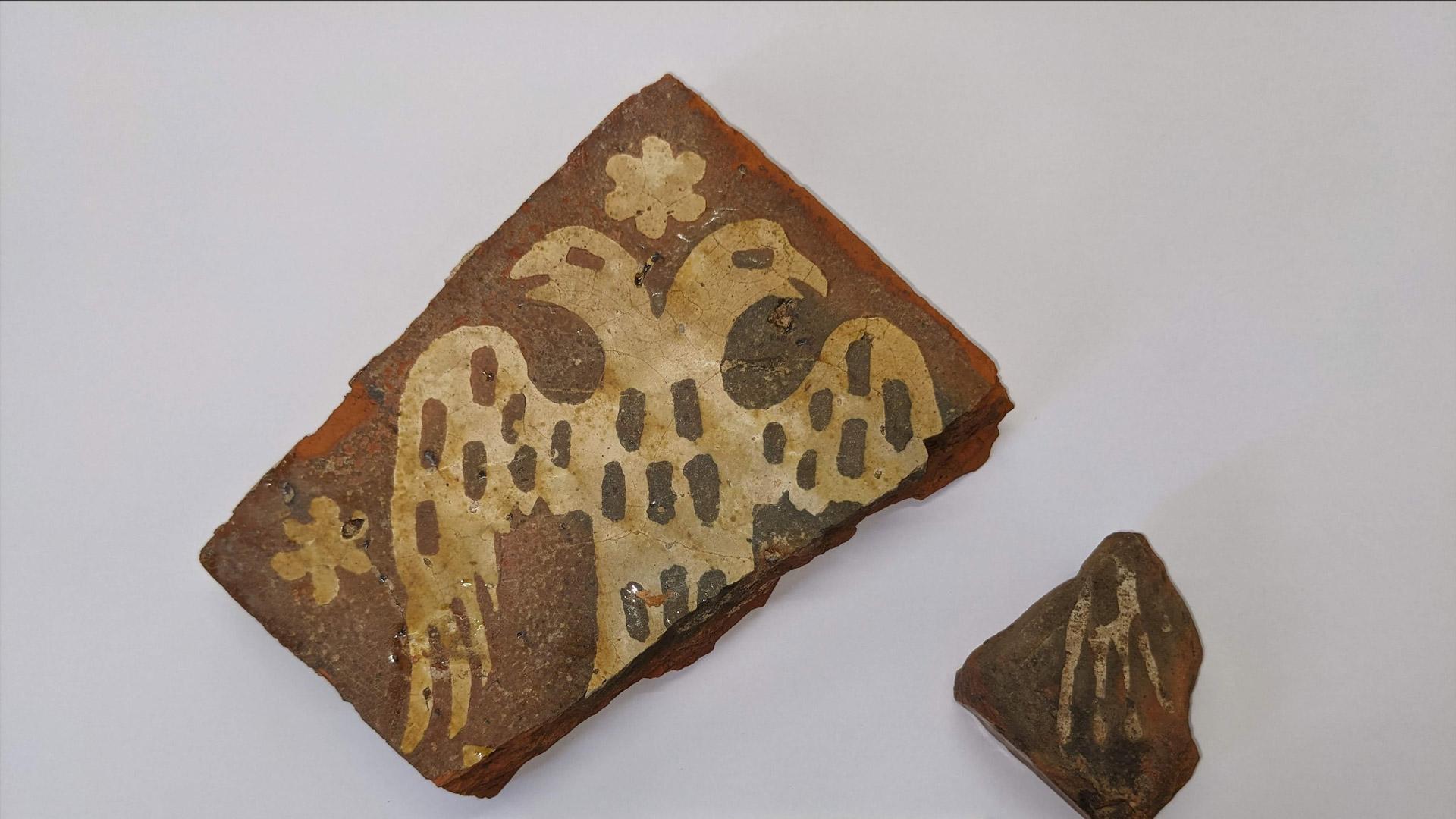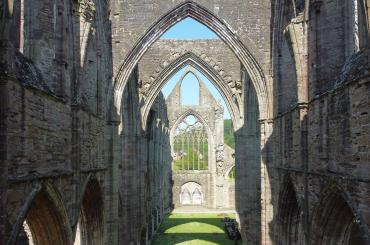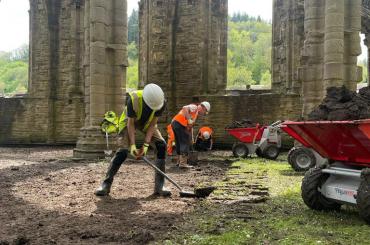Iconic Tintern Abbey features on BBC’s Digging for Britain
Cadw’s ambitious five-year programme of essential conservation works at the iconic Tintern Abbey will be the focus of BBC2’s Digging for Britain on Thursday 4 January.
Tintern’s greatest glory, the Gothic Church, has stood on the banks of the River Wye for over 700 years. Over the centuries, the weather has eroded the soft medieval stonework and a large-scale conservation project is now underway to preserve the monument and make it safe for visitors.
Archaeological investigations began on site in the summer to help inform the conservation works, which will address natural erosion and weathering. This includes historical research, surveys, detailed recording of the standing remains of the building and excavations to help understand the nature of below ground archaeology.
The conservation works which will go ahead later this year, require a very high and heavy scaffold. Before the scaffold is installed, Black Mountains Archaeology and ArchaeoDomus were commissioned to undertake archaeological evaluations, to avoid any ancient fragile features buried in the ground that may be damaged and to ensure that the scaffold has a stable base.
The Digging for Britain team has been on site at Tintern following the excavation works with some of the finds being featured as part of Thursday’s programme, including the remains of some the former occupants analysed by Cardiff University and possibly patrons of the abbey.
Many interesting artefacts have been recovered from the late 13th century to the modern period helping to understand the development of the abbey across the centuries. These include, fragments of rare medieval window glass, floor tiles and pottery, and coins from Henry III (1216 to 1272), George III (1760 to 1820), through to the Victorian and Edwardian Periods. The remains that have been found on the site will also feature in the Digging for Britain programme.
Head of Cadw, Gwilym Hughes, said:
“For over 700 years the abbey’s church has been welcoming worshippers, wealthy patrons and visitors to this tranquil location, and once again it requires some attention.
“What has been discovered so far has taught us so much more about and enhanced our knowledge and understanding of Tintern Abbey, its history, buildings and archaeology.
“I’m delighted that the viewers of Digging for Britain will get the opportunity to get an insight to the work that is being carried out.”
Presenter of Digging for Britain, Alice Roberts, said:
“It was a huge privilege to visit Tintern as archaeologists discovered more about this beautiful and iconic historic landmark. I loved seeing some of the original decorated floor tiles, buried under the demolition rubble of later periods. The archaeological work is part of a bigger project to conserve this wonderful building, keeping it safe for future generations.”
Richard Madgwick, Reader in Archaeological Science, Cardiff University, said:
“We have only analysed a few burials from the abbey so far but these are already providing unparalleled new insights into the lives of the medieval and post-medieval inhabitants of the area. These include poignant stories including what appears to be a much cared for disabled person laid to rest in a hastily cut grave just next to the abbey after the reformation, showing that even when the abbey was out of use it still held special significance for some locally.
We are now embarking on an ambitious programme of molecular analysis to build up more detailed biographies, including assessments of diet, health and origins.”
Richard Lewis, Managing Director, Black Mountains Archaeology, said:
"We are very excited to be supporting Cadw with this ambitious, landmark conservation programme for Tintern Abbey’s Great Church. This will be the first time that the abbey church will have been investigated in such detail since the Ministry/Office of Works carried out their landscaping and excavations nearly 100 years ago and offers an exciting opportunity for us to learn more about the magnificent building.
"It has already significantly improved our understanding of the construction sequence and how this came to replace the earlier. One of the most interesting discoveries is the extensive landscaping of both the medieval period, which transformed the landscape around the monastic settlement, and those of the conservation efforts from the 1750s to the present day, as part of a picturesque site and tourist attraction.
"We are currently investigating a large area of the church and we are recording the monument using the latest modern digital archaeological recording techniques. We are using cutting edge photogrammetry and laser methods, together with bespoke digital software to record the investigations in 3D. This will provide a detailed, holistic and lasting record for the future."
Ross Cook, Buildings Archaeologist and Dendrochronologist at ArchaeoDomus, said:
“The nature and scope of the investigations at Tintern are unprecedented and will provide the most comprehensive record of a Scheduled Monument in Wales.
“The programme of buildings recording will explore every inch of the monument and create a 'living' database of information relating to its pre- and post-conservation condition and historical development. This will continue to be added to in the future to support the management of this beautiful and important site. It's a very exciting project to be a part of and great to work alongside Cadw and a wonderful team including acknowledged specialists in the history of the Cistercians and masonry conservators.
“The excavations have already helped improve our understanding of the construction and development of the abbey church in both the pre- and post-Reformation medieval world. So far, we have finds that have helped improve our understanding of the development of the abbey between the first and second churches. In particular, the quantity and range of medieval floor tiles, stained glass, and small pieces of painted plaster, have begun to paint a picture of how the later church once looked.
"Burials of both the early and later abbey churches have been unearthed, which has revealed simple burials in the Cistercian manner to high status burials of secular elites. Importantly, a number of post-Dissolution burials have also been discovered, suggesting secret Catholic interment continued after Henry VIII Protestant Reformation.”




